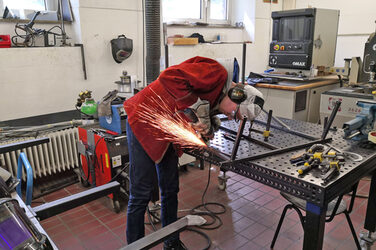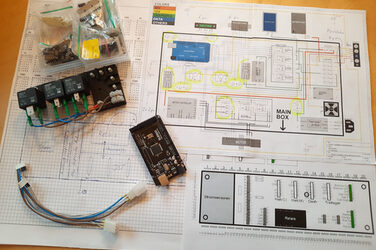It's the perfect day for an extensive test ride: the summer sun shines over Dortmund's Phoenixsee lake as an unusual tricycle attracts curious glances.
"Super device!", comments a stroller enthusiastically, while a little boy next to him is obviously wondering with astonished eyes what exactly is standing in front of him. Students Nils Margott, Tom Miklejewski and Carsten Schulz are enjoying the attention they are attracting with their "Trisone" vehicle. Trisone?
"The name is easy to explain," says Nils. "We put it together from three abbreviations: Tri stands for the three wheels, son for solar energy and e for electric drive." And with that, Nils has basically already revealed what the key ingredients for their Trisone are. The prototype is the impressive and sophisticated result of her bachelor's thesis in the Vehicle Development study program at the Faculty of Mechanical Engineering at Dortmund University of Applied Sciences and Arts - with this focus:
- Nils: Electronics & Concept
- Tom: Package, ergonomics & chassis
- Carsten: Chassis & Steering
NilsWe wanted to do something practical as a bachelor's thesis that you could really use.
Nils is the first to take a seat in the white plastic seat between the bikes - two smaller ones at the front, one larger one at the back. He grips the two handlebars next to him and stretches out his legs to pedal with ease. The trike (short for tricyle) starts moving immediately.
From the front, the pedaling movements are barely visible, as a large solar module is mounted above the front axle, with only part of Nils' upper body protruding above it. The shimmering bluish panel is tilted upwards at an angle to capture solar energy (output: 100 watts in direct sunlight). This can either be stored in a lead-acid battery - for example when parking - or used directly while riding to drive the wheel hub motor integrated in the rear wheel and increase the range. A small display on the top edge of the solar module shows Nils the speed, the battery charge level as a percentage and the distance covered by the Trisone.
NilsThe electric pedal assistance really only works when I'm pedaling at the same time.
Legally, the Trisone is a pedelec (of course it also has brakes, lights and a bright bell), so you can ride it anywhere where a bicycle is permitted. A special operating license is not required. The motor power is 1000 watts (around 40 km/h), but this is reduced by software to a maximum of 250 watts (25 km/h) in order to comply with the road traffic licensing regulations (StVZO).
"We developed and manufactured the Trisone ourselves over a period of around twelve months. We were also able to draw on the support of several companies, for example for the powder coating for corrosion protection. We were also able to use the SQuArE(Opens in a new tab) makerspace and other workshops at the university of applied sciences, especially for machining the metal parts," says Nils.
Impressions from the development process
As they financed the Trisone themselves (material costs around 1,400 euros), they deliberately opted for low-cost components in some areas. The total vehicle weight of 60 kilograms (the frame alone weighs only 12) could therefore be optimized with even lighter but more expensive components - for example with a lithium-ion battery instead of the lead-acid battery.
Successful test drive
In any case, the students' motorized tricycle mastered the test ride at Phoenixsee without any problems, it withstood all loads and the range test of the battery showed a proud 25 kilometers despite little solar yield due to the now low evening sun.
"With our roadworthy prototype, we have shown how sustainable mobility can work for everyday use," summarizes Nils, who continues to study vehicle development with Carsten and Tom in the Master's program at Fachhochschule Dortmund. What new project they will be working on next and what they might soon be using to attract curious glances again will remain a secret.




